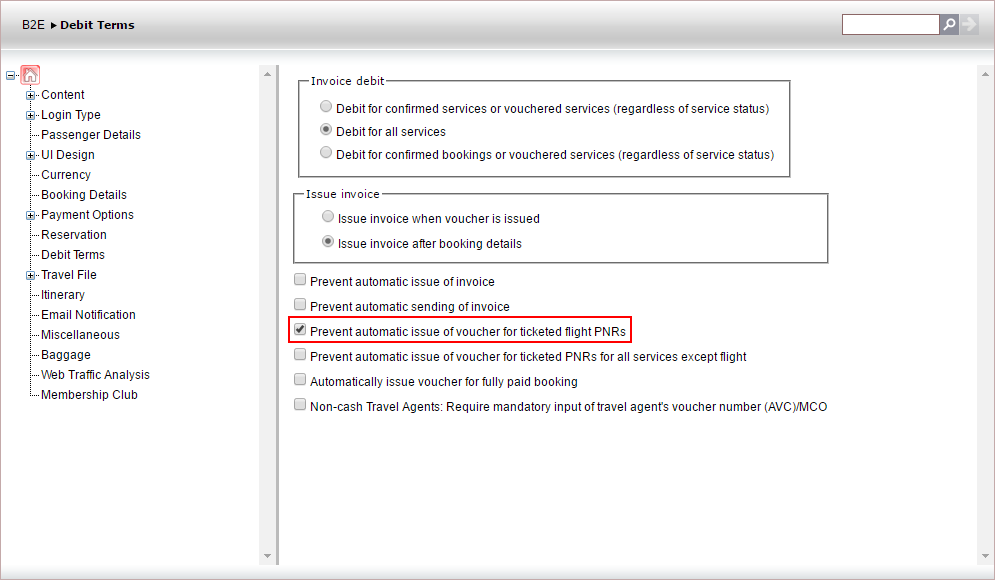
This topic explains the different work procedures for working with Sabre or Amadeus in the system.
Sabre and Amadeus are Global Distribution Systems (GDS). These GDS enable online reservation of travel services .
When working with these GDS, users will create a passenger name record (PNR) in the GDS. The system then brings the PNR into the system (automatically or manually by the user) and will either create a new travel file or update an existing travel file.
All actions performed in the GDS automatically update the travel file.
The method through which the system brings the PNR into the system is different for each GDS. The result however is the same for both of them.
With Sabre, the system uses the Event Notification Services (ENS). ENS is a Sabre webservice that allows the system to subscribe to the GDS to receive notifications. Sabre then automatically updates the system whenever a new PNR is created or when an existing PNR is changed.
With Amadeus, the system periodically connects to the GDS, and brings into the system new PNRs that have been created or existing PNRs which have been updated.
When bringing a PNR into the system, the system compares the information in the PNR to the existing travel files. If a new PNR was created, a new travel file is opened and new transactions are created. If the PNR matches a transaction in an existing travel file, the transaction is updated.
To determine a match, the system checks for the following information: flight route, flight numbers, and flight tickets. If the information is the same in both the PNR and the transaction, the transaction is updated.
If a specific travel file number is saved in the PNR, the system will import the PNR into that travel file.
If a group PNR is imported, a group travel file is created in the system.
Search and reserve flights through the Reservations System
Automatically cancel travel files and transaction fees when PNR is cancelled in GDS
Automatically create and update travel files if PNR is ticketed in GDS
If you are not using the ENS, there are two primary methods for importing PNRs into the system: From PNR and GDS to TB.
From PNR is a tool that users can use to import PNRs into the system through an API directly from the GDS. GDS to TB is a tool used for importing PNRs from PNR files, which users then review in the Dashboard, and either create a new travel file, update an existing travel file or delete the PNR.
From PNR can be used by users after the GDS credentials are entered in the website definitions. If you want to automate the process, you need to activate the ENS if you are working with Sabre, or subscribe to a queue if you are working with Amadeus.
The table below details which information is returned from each GDS using each method.
Sabre - From PNR |
Amadeus - From PNR |
Sabre - GDS to TB |
Amadeus - GDS to TB |
|
PNR |
✔ |
✔ |
✔ |
✔ |
Dates |
✔ |
✔ |
✔ |
✔ |
Times |
✔ |
✔ |
✔ |
✔ |
From IATA code |
✔ |
✔ |
✔ |
✔ |
To IATA code |
✔ |
✔ |
✔ |
✔ |
Airline |
✔ |
✔ |
✔ |
✔ |
Flight number |
✔ |
✔ |
✔ |
✔ |
Class |
✔ |
✔ |
✔ |
✔ |
Status |
✔ |
✔ |
✔ |
✔ |
Terminals |
✔ |
✔ |
X |
✔ |
Equipment |
✔ |
✔ |
✔ |
✔ |
Milage |
✔ |
✔ |
✔ |
X |
Stops |
✔ |
✔ |
✔ |
✔ |
Fare Basis |
✔ |
X |
X |
✔ |
Operated by |
✔ |
✔ |
X |
✔ |
Airline PNR |
✔ |
✔ |
X |
X |
Time Limit |
X |
✔ |
X |
X |
GDS to TB is configured in two places:
Database definitions: Define where the system should import the PNR files from.
Automatic processes: Define the interval in which the PNR files should be imported into the system.
After the tools are configured, in the website definitions for each configuration, for each GDS you need to select the method through which the system will import the PNRs into the system.
Ticketing is done in the GDS.
After the ticket is issued in the GDS, the flight transaction needs to be updated from the GDS. Once the transaction is updated, a voucher is automatically issued in the travel file by default.
To prevent the voucher from being issued automatically in the travel file, in Setup - Website Definitions - Debit Terms, select Prevent Automatic Issue of voucher for ticketing PNR.

If this option is selected, users will need to manually issue the voucher in the travel file.
Sometimes users need to reissue an existing ticket with a new number because of a change in the flight schedule or classes (or when it is no longer possible to void a ticket, and it is cheaper to reissue the ticket than issue a refund).
When a ticket is reissued, both tickets are still active, and therefore an additional transaction is added to the travel file with the new ticket, and the legs that are no longer relevant are cancelled.
A user can mark a ticket as Void in the GDS on the same day it is issued (until 23:59), and before it is reported to the BSP. Because a void ticket has not yet been reported to the BSP it can be removed from the system and the transaction, allowing you to replace it with a new ticket if necessary.
If the system identifies a void ticket in a PNR:
If a voucher has not yet been issued for the ticket, the tickets are deleted from the transaction.
If a voucher has been issued, the voucher is cancelled, and the ticket is deleted from the transaction.
After the user removes the itinerary from the PNR, the transaction is deleted from the travel file.
When a user issues a in the GDS, once the PNR is imported into the system, a refund application is issued automatically.
Electronic Miscellaneous Documents (EMD) are electronic non-flight vouchers that can be issued in the GDS to purchase additional services from the airline, such as additional checked baggage, or extra leg space.
When importing the PNR, EMD are added to the travel file as a general transaction with the following information:
Name: Electronic Miscellaneous Document or the type of EMD.
Passenger: The passenger connected to the ticket in the PNR
PNR Number
Ticket Number
Dates: The start date and end date of the related segment
Suppliers:
Reserving supplier and service provider - the airline from the PNR
Supplier paid - the supplier in the Payment by company field, in the reserving supplier's account. If there is no supplier in this field then the reserving supplier is used
EMD transactions are recognized in the BSP reconciliation process.
If you are working with Sabre, Void and refund EMD transactions are handled automatically when the PNR is imported. If you are working with Amadeus, void and refund EMD transactions need to be handled manually.
You can map between the user's user name in the system and the user's user identifier and PCC/OfficeID in the GDS. The mapping is defined in Setup - Users - <User Name>.

Mapping the user name enables the system to import the user name of the user who opened the PNR into the system and add it to the travel file.
The user name is saved in the transaction as the user who issued the voucher. If a tax invoice is issued when issuing the voucher, the user is also saved as the user who issued the tax invoice.
When importing the PNR:
The system first searches for a user with a user identifier and PCC/OfficeID for the GDS in the mapping table.
If no user is found, the system searches for a user who has the exact same name as the user identifier returned from the GDS.
If no user is found, or no user information was returned from the PNR:
For manual import (From PNR or GDS2TB), the system takes the user currently logged into the system.
For automatic import (ENS or Queues), the user takes the default login user defined in Setup - Website Definitions - Travel File. If no default login user is defined, the system takes the hardcoded user: automatic.
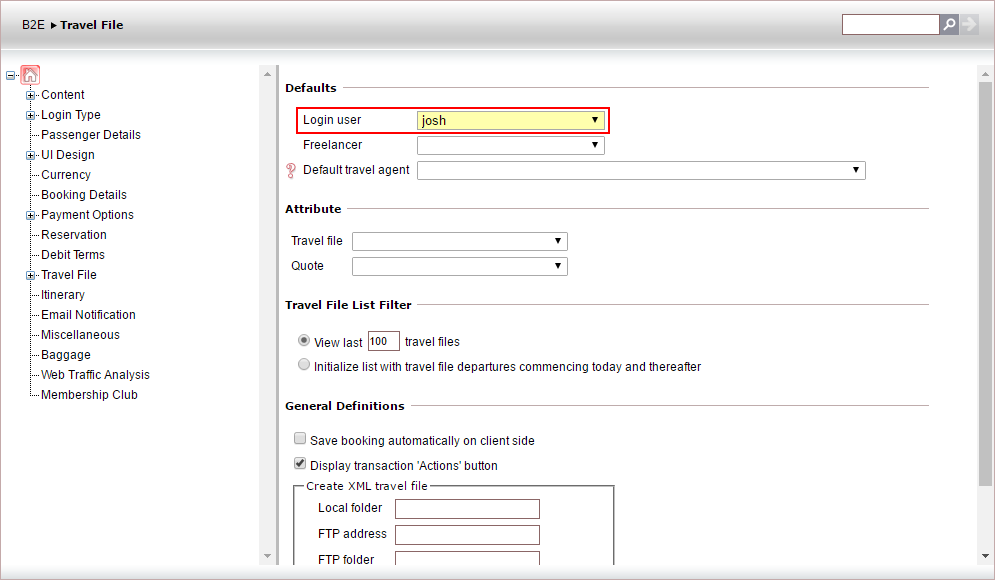
When a user cancels the PNR in the GDS, when the PNR is imported into the system:
If a voucher was not issued: The transaction is deleted.
If a voucher was issued: You need to manually delete the ticket and then the transaction.
Some customers want their credit card to be billed directly when the ticket is issued. These customers (usually corporate clients) have an agreement with the GDS, and when the PNR is created their credit card information is saved in the PNR. When the system imports a PNR with credit card data, the system bills the client directly. The credit card is saved to the transaction, and the payment method is defined as Credit Supplier.
When the system imports a PNR that was divided/split, the system always imports the PNR into the existing travel file that was opened for the passenger.
After the system imports the divided/split PNR from Sabre or Amadeus Webservices:
If the transaction has not yet been ticketed:
The transaction is divided and a new transaction is created for the passenger who was divided/split from the PNR.
In the original transaction, the passenger is removed and the price is updated accordingly.
If the PNR is divided/split after a ticket is issued:
A new transaction is created and ticketed. The ticket number for the divided/split passenger is added to the new transaction.
The original transaction is amended. The passenger who was divided/split is removed and the price is updated accordingly.
If the PNR is divided/split after the ticket is issued and the voucher is paid for or in use:
The original transaction remains unchanged.
A new transaction is created with no ticket number and the price is 0.
Any refunds issued in the GDS are added to the original transaction.
A complex PNR is a PNR that has more than one ticketing airline. This means that the PNR includes several segments, and different segments are ticketed by different airlines. When the PNR is opened into a new travel file, a single flight transaction is created. After the PNR is ticketed, the flight transaction is automatically divided into separate transactions for each ticketing airline.
When importing the PNR, the system automatically calculates the commission as the difference between the supplier price and the net to remit price and attaches it to the flight transaction. The commission can then be used in the various reconciliation procedures. The VAT definition (include VAT, plus VAT, VAT zero, or VAT exempt) is taken from the supplier account.
By default, only one PNR can be imported into a travel file, and therefore separate travel files are created for each PNR.
However, there are several options for importing a new PNR into an existing travel file:
Manually: In the travel file, use the From PNR tool (as mentioned previously)
Automatically: In Setup - Website Definitions - Reservation Systems, in the Unite PNRs section, select Import new PNR to existing travel file. Only PNRs that match the travel file are imported.
This option does not apply to group travel files. When importing a group PNR, the system creates a group travel file. If there are individual passengers in the PNR with separate travel arrangements, the system opens a new individual travel file which is linked to the group travel file.
A match is determined as follows:
All the passengers in the PNR exist in the travel file. Passenger names, phone numbers, index numbers (if they exist in the PNR), and employee IDs if relevant are compared.
The user attached to the travel file and the user who created the PNR share the same branch.
There is up to a 48 hour overlap between the start and end dates.
If there is a match with a closed travel file, the PNR is not imported. If there is a match with a travel file that has the status Cancel, the PNR is imported and the system automatically changes the travel file status back to Open.
If the PNR contains the remark New Travel File, the PNR is imported into a new travel file, even if it was supposed to be imported into an existing travel file. However, if the the PNR already exists in the system or contains a specific travel file number, it will be imported into an existing travel file, and the remark will be ignored.
Manually when creating the PNR: If the PNR contains the remark TB<travel file number>, the PNR will be imported into the travel file with that number. The remark needs to be added when the PNR is first created.
Users can move flight transactions to new or existing travel files, which is useful when multiple PNRs are imported into the same travel file and you want to manage the transactions separately.
The flight transaction can only be moved if no documents have been issued.
When moving a flight to an existing travel file, the existing travel file has to contain the same passengers as the original travel file.
To move the flight transaction, in the travel file, in the Services section, click the Actions button, and select Move transaction, and then choose either to create a New Travel File or move the flight transaction to an Existing Travel File.
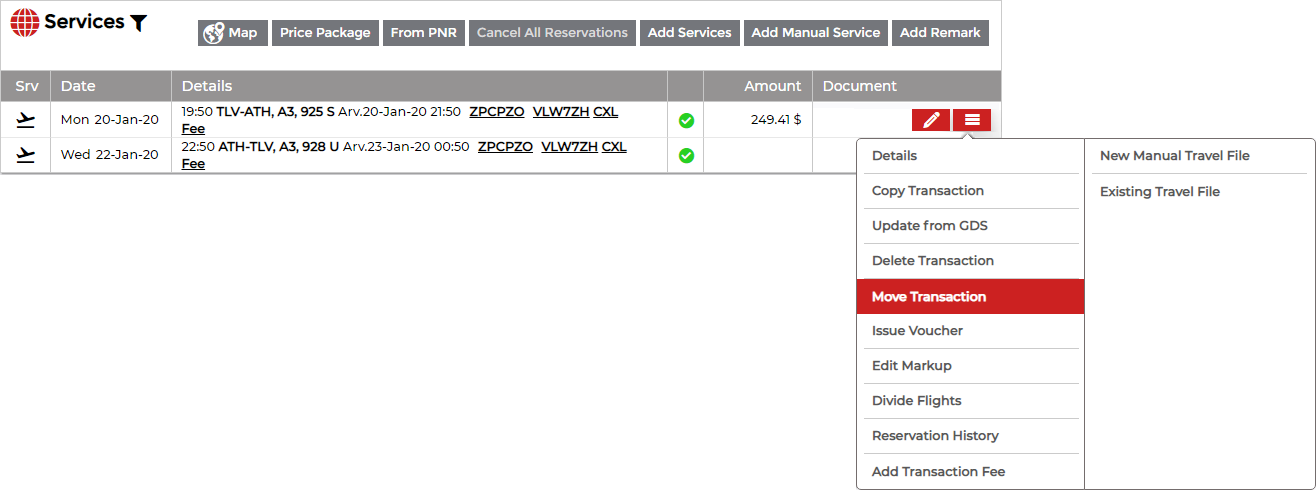
When a PNR is imported into the system, if a passenger already exists in the database, and the information in the PNR is different in even one parameter, a new passenger is created that shares most of the information of the old one (this occurs usually when entering the passenger name without the e-mail address). This can lead to the existence of multiple passengers in the system for the same person.
When importing a PNR, the system compares the passenger's name, and e-mail address or ID number. If the name exists, and the e-mail or ID are missing or different, the system also checks the passenger's phone number. If the phone number matches, the passenger's account is updated in the system. If the phone number is missing, the system creates a new passenger.
The system uses the Search by field in Setup - Website Definitions - Passenger Details to determine whether it checks the passenger's e-mail or ID.
There are two methods for preventing duplicate passengers from being created:
TB to GDS
"Pax" Sabre & "Galor" Amadeus
There is also a Unite Passengers tool that allows you to remove existing duplicate passengers from the system.
You can prevent the system from creating new travel files when importing specific PNRs.
The PNRs need to contain a remark with the characters dpc.
To activate this feature:
Amadeus: As a TBA user, go to Setup - Website Definitions - Reservation Systems - Amadeus WS, in the Queue Definitions section, select Do not import PNRs from Q with remarks from other systems.
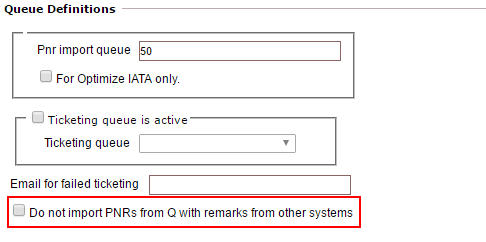
Sabre: Go to Setup - Website Definitions - Reservation Systems - Sabre, in the General section, select Do not import PNRs from the ENS with remarks from other systems.
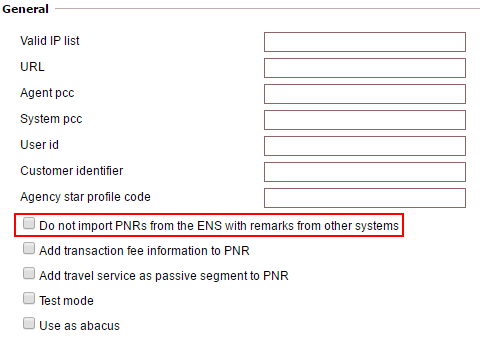
You can have the system automatically cancel travel files and transaction fees when an XI command is performed in the GDS.
To activate this feature:
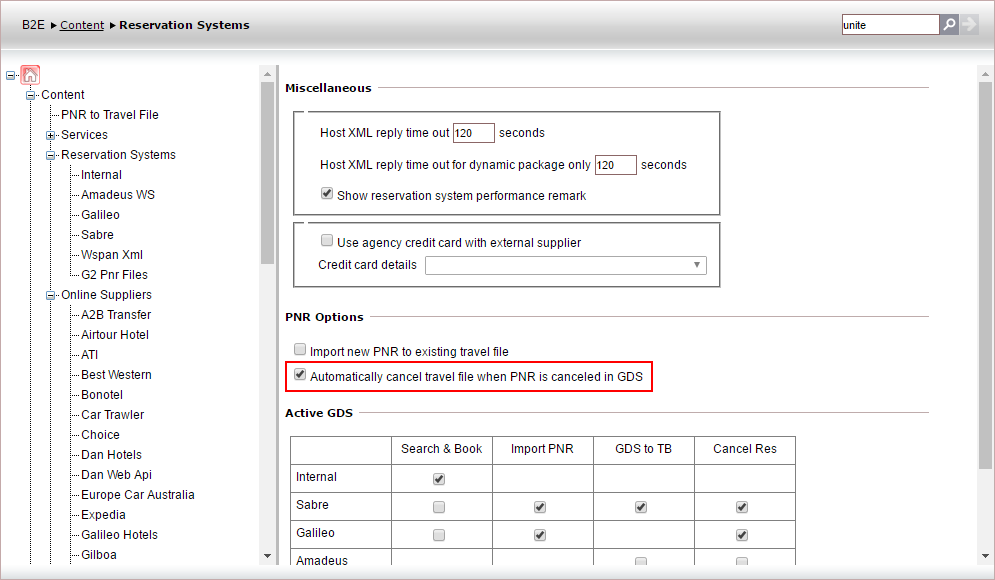
Select Travel Files and transaction fees can be automatically cancelled when PNR is cancelled in GDS.
When this option is selected, when an XI command is performed in the GDS, and the flight transaction is removed from the travel file, if there are no other transactions in the travel file:
Any tax invoices issued for transaction fees in the travel file are automatically cancelled
All transaction fees in the travel file are automatically deleted
The status of the travel file is changed to Cancel.
This option does not affect travel files containing other financial documents (for example a receipt).
When a PNR is brought into the system, the system can read the passenger information in the GDS and update the passenger details.
Date of birth: If the passenger's date of birth is returned in the PNR, the system updates the passenger's account with the returned information.
Phone numbers: If the passenger does not have a phone number, and the GDS returns a phone number, the phone number is added to the passenger's account.
Passport information: If the PNR returns passport information (number, expiration date, and nationality), and:
The passenger does not have a passport number - the system adds the passport information to the passenger's account.
The passenger has an identical passport number, but the nationality is different - the system adds the passport information as an additional passport to the passenger;s account.
If the passenger has an identical passport number and nationality, and the expiration date in the PNR is later - the system updates the passport in the passenger's account with the expiration date from the PNR.
If the passenger has an identical passport number only - the system updates the passport information with the information returned from the PNR.
Frequent flyer information: If the PNR returns frequent flyer information, and:
If the passenger has a frequent flyer airline and number - the system does nothing.
If the passenger does not have a frequent flyer airline or number - the system adds a the frequent flyer information returned from the PNR to the passenger's account.
The following information is returned from each GDS:
|
Sabre |
Amadeus Webservices |
| Date of birth | ✔ |
✔ |
| Phone number | ✔ |
✔ |
| Passport | ✔ |
|
| Frequent Flyer | ✔ |
|
If you do not have a workflow in which transactions are automatically updated, you can manually update the transaction in the travel file.
To update the transaction: In the travel
file, in the Services section,
click the Actions ( ) button and select Update from GDS.
) button and select Update from GDS.
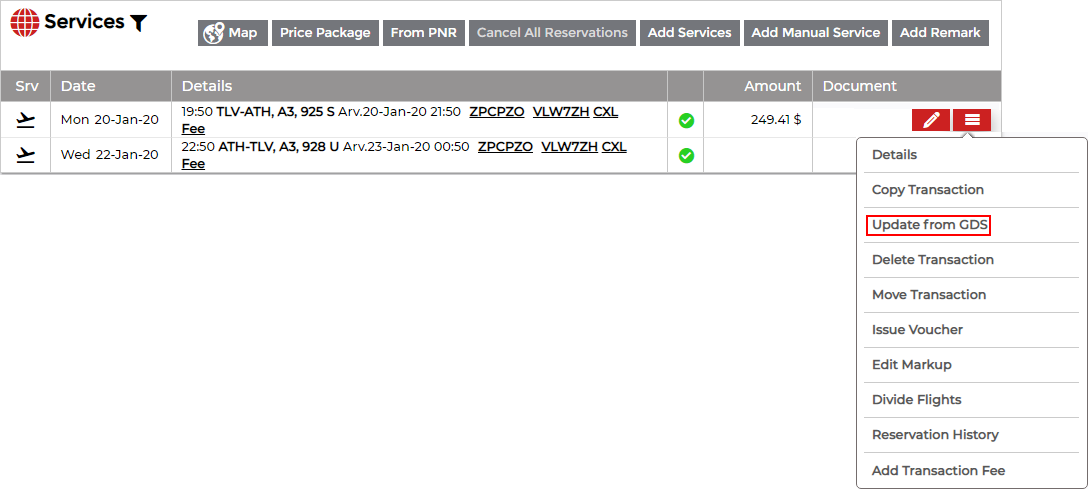
if you are working with the Sabre ENS or Amadeus queues, you have an option to enable new travel files to only be created when the PNR is ticketed in the GDS, instead of when the PNR is created. This option is controlled by a user permit.
In the user permits, in the Reservation System Permits expander, there is a permit: Create travel file only after PNR is ticketed in GDS.
If this permit is selected, when importing PNRs into the system, only ticketed PNRs will create new travel files or update existing travel files attached to the user.
Ticketed PNRs are PNRs in which there is a: ticketed flight, ticketed EMD, hotel reservation, or car rental reservation.
If the PNR contains hotel or car rental reservations, if a voucher was issued, and the voucher has not been selected or covered in the Supplier Reconciliation module:
If the name and reservation number of the hotel in the PNR are identical to the hotel transaction, and the details of the hotel reservation have been changed (dates, prices, pick-up or drop-off stations and rooms), in the travel file, the transaction is updated and the voucher is amended with the new information.
If the reservation is cancelled in the PNR, in the travel file the voucher is cancelled and the transaction is deleted.
If the voucher is selected or covered, the original transaction in the travel file will remain unchanged after the PNR is imported. If the reservation details are changed, a new transaction will be created in the travel file. If the reservation is cancelled in the PNR, the transaction in the travel file will remain active. |